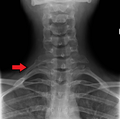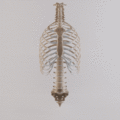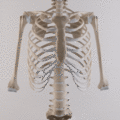Rib cage facts for kids
Quick facts for kids Rib cage |
|
|---|---|
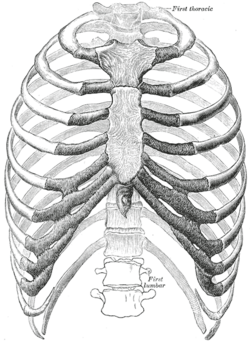 |
|
| The human rib cage. (Source: Gray's Anatomy of the Human Body, 20th ed. 1918.) | |
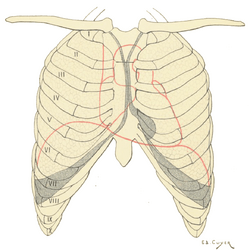 |
|
| Projection on the rib cage of the heart, lungs and diaphragm. The shaded areas indicate the extent of the pleural cavities not filled by the lungs. | |
| Latin | cavea thoracis |
The ribcage is a part of the skeleton of humans and some animals. It is made up of curved bones called ribs. The rib cage is found in the chest area.
It protects a person's internal organs from damage.
Most humans have 12 pairs of rib bones with one from each pair on each side of the chest. Some people may have 11 or 13 pairs of rib bones. The bones are also filled with bone marrow.
The bones that are connected to the sternum directly are called true ribs, and the bones that are connected to the sternum indirectly, through the seventh bone, are called false ribs (eighth, ninth, and tenth bones), and the bones which are not connected to the sternum, and is connected to the back bone, are called floating ribs.
If these floating ribs were connected to the sternum, we could not breathe properly, as the chest needs space to expand and decrease. The rib cage is also called the thoracic cavity.
The rib cage has a major function in the respiratory system.
Structure
Ribs are described based on their location and connection with the sternum. All ribs are attached behind to the thoracic vertebrae and are numbered accordingly one to twelve. Ribs that articulate directly with the sternum are called true ribs, whereas those that connect indirectly via cartilage are termed false ribs. Floating ribs (eleven and twelve) are not attached to the sternum at all.
Images for kids
-
The effect of the contraction of the accessory muscles of inhalation, pulling the front of the rib cage upwards, a movement known as the 'pump handle movement'. This increases the antero-posterior diameter of the thorax, contributing to the expansion in the volume of the chest. A similar effect, known as the 'bucket handle movement' causes the transverse diameter of the chest to increase, because not only do the ribs slant downwards from the back to the front, but, in the case of the lower ribs, also from the midline downwards to the sides of the chest.





